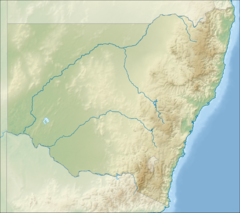Wollemi National Park
| Wollemi National Park | ||
|---|---|---|
| Wollemia | ||
|
|
||
| Location: | New South Wales , Australia | |
| Specialty: | Forest and gorges in mountain landscape, Wollemien | |
| Next city: | Richmond - Sydney | |
| Surface: | 5,017.03 km² | |
| Founding: | 1979 | |
| Capertee River | ||
The Wollemi National Park is a national park in the region of the Blue Mountains on the west side of the Great Dividing Range in the Australian state of New South Wales and is part of the UNESCO World Heritage Blue Mountains World Heritage Area . Around 40% of the national park are wilderness areas , which means that they are protected and managed in such a way that their natural state is preserved.
In 1994 a hitherto unknown species of the araucarias was discovered here and named Wollemie . These trees grew 200 million years ago and were considered extinct. The name comes from the Aborigines and means to be attentive (in the sense of keeping your eyes open). There are a number of Aboriginal rock paintings in the park. When the bush fires in Australia in 2019/2020 also developed in the national park, firefighters who abseiled themselves from helicopters into a ravine where wollemia thrive, took targeted measures to protect the slightly fewer than 200 wollemia trees from the fires.
In the park there is the so-called "glow worm tunnel", an old disused railway tunnel in which these insects multiply due to its dampness and darkness and provide a remarkable illumination .
You can go hiking or canoeing in this park. There are three campsites in Newnes, Wheeny Creek and Dunns Swamp that are accessible by car. Another place, however, has to be hiked.
Geography and climate
The park is bounded to the east by Putty Road and to the south by the Bells Line of Road . In the west there are pastures and some small towns; to the north the Hunter Valley . The next larger towns are Lithgow and Mudgee in the west, the localities of Blue Mountains City in the south and Sydney with the district of Richmond in the southeast.
Goulburn River National Park , Gardens of Stone National Park , Blue Mountains National Park , Yengo National Park and several State Conservation Areas border the Wollemi National Park.
As part of the Blue Mountains, the sandstone plateau of the Wollemi National Park, cut deep by river valleys, rises from east to west from 300 m to 1100 m, where the altitude then drops again sharply. Precipitation increases with altitude (from 700 to 800 mm per year in the east to 1200 to 1400 mm in the west) and the average temperature decreases. Some of the park's more significant rivers include the Wolgan River , Colo River , Capertee River, and Widden River .
geology
see also : Blue Mountains (geology)
The national park is located on the western edge of the Sydney Basin and consists mainly of the sandstone and clay layers of the Narrabeen Group .
Flora and fauna
see also : Blue Mountains (flora and fauna) As in the other parts of the Blue Mountains, eucalyptus dominates the landscape. The discovery of Wollemie, unknown until 1994, was considered "spectacular"; the exact location is kept secret.
literature
- NSW National Parks and Wildlife Service (2001) Wollemi National Park. Plan of Management. ( Memento of April 12, 2011 in the Internet Archive ) (PDF; 620 kB) ISBN 0-7313-6979-3 .
- NSW National Parks and Wildlife Service (2004) Greater Blue Mountains World Heritage Area. Northern Journeys ISBN 0-7313-6765-0
Individual evidence
- ^ NSW National Parks and Wildlife Services (2005) Wollemi National Park. Visitor guide
- ↑ Dinosaur trees': firefighters save endangered Wollemi pines from NSW bushfires , January 15, 2020, on The Guardian . Retrieved January 16, 2020
- ↑ a b c NSW National Parks and Wildlife Service (2001), page 3
- ^ A b NSW National Parks and Wildlife Service (2001), page 9.
- ^ NSW National Parks and Wildlife Service (2004), page 59



